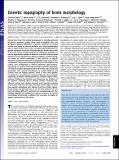Genetic topography of brain morphology
Author(s)
Chen, Chi-Hua; Fiecas, Mark; Gutierrez, E. D.; Panizzon, Matthew S.; Eyler, Lisa T.; Vuoksimaa, Eero; Thompson, Wesley K.; Fennema-Notestine, Christine; Hagler, Donald J., Jr.; Jernigan, Terry L.; Neale, Michael C.; Franz, Carol E.; Lyons, Michael J.; Fischl, Bruce; Tsuang, Ming T.; Dale, Anders M.; Kremen, William S.; ... Show more Show less
DownloadChen-2013-Genetic topography o.pdf (827.9Kb)
PUBLISHER_POLICY
Publisher Policy
Article is made available in accordance with the publisher's policy and may be subject to US copyright law. Please refer to the publisher's site for terms of use.
Terms of use
Metadata
Show full item recordAbstract
Animal data show that cortical development is initially patterned by genetic gradients largely along three orthogonal axes. We previously reported differences in genetic influences on cortical surface area along an anterior-posterior axis using neuroimaging data of adult human twins. Here, we demonstrate differences in genetic influences on cortical thickness along a dorsal-ventral axis in the same cohort. The phenomenon of orthogonal gradations in cortical organization evident in different structural and functional properties may originate from genetic gradients. Another emerging theme of cortical patterning is that patterns of genetic influences recapitulate the spatial topography of the cortex within hemispheres. The genetic patterning of both cortical thickness and surface area corresponds to cortical functional specializations. Intriguingly, in contrast to broad similarities in genetic patterning, two sets of analyses distinguish cortical thickness and surface area genetically. First, genetic contributions to cortical thickness and surface area are largely distinct; there is very little genetic correlation (i.e., shared genetic influences) between them. Second, organizing principles among genetically defined regions differ between thickness and surface area. Examining the structure of the genetic similarity matrix among clusters revealed that, whereas surface area clusters showed great genetic proximity with clusters from the same lobe, thickness clusters appear to have close genetic relatedness with clusters that have similar maturational timing. The discrepancies are in line with evidence that the two traits follow different mechanisms in neurodevelopment. Our findings highlight the complexity of genetic influences on cortical morphology and provide a glimpse into emerging principles of genetic organization of the cortex.
Date issued
2013-10Department
Massachusetts Institute of Technology. Computer Science and Artificial Intelligence LaboratoryJournal
Proceedings of the National Academy of Sciences
Publisher
National Academy of Sciences (U.S.)
Citation
Chen, C.-H., M. Fiecas, E. D. Gutierrez, M. S. Panizzon, L. T. Eyler, E. Vuoksimaa, W. K. Thompson, et al. “Genetic Topography of Brain Morphology.” Proceedings of the National Academy of Sciences 110, no. 42 (September 30, 2013): 17089–17094.
Version: Final published version
ISSN
0027-8424
1091-6490